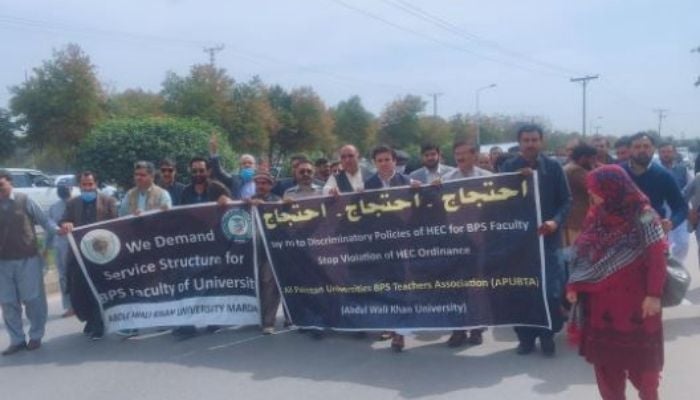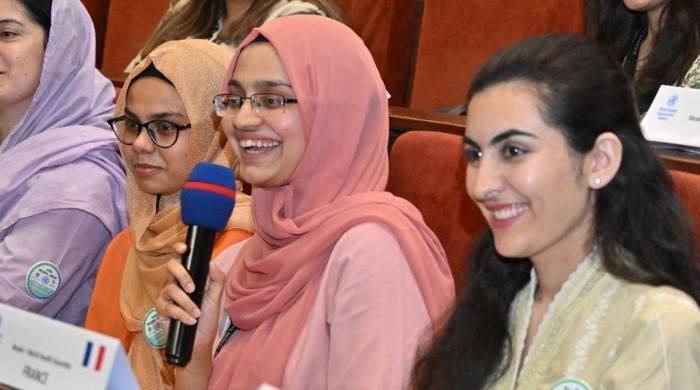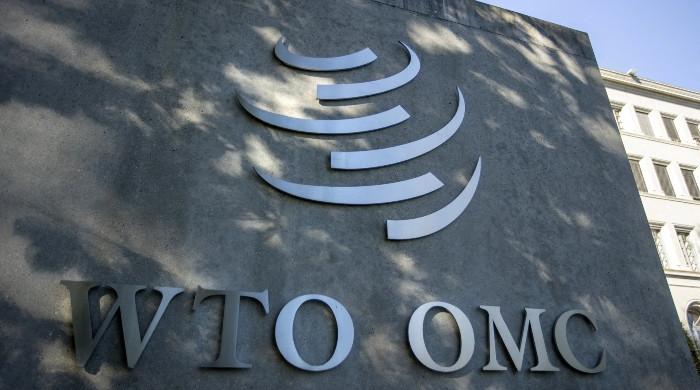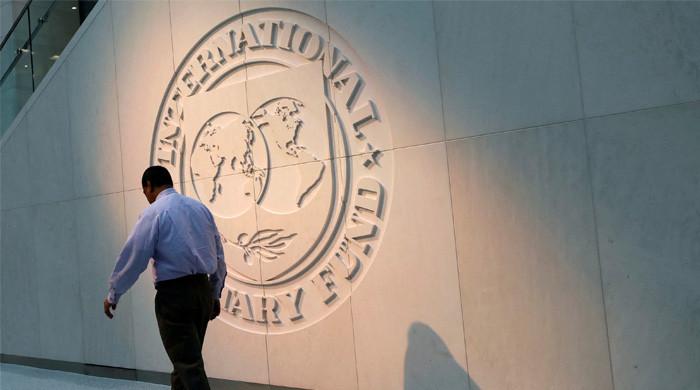Here is why professors of public universities are protesting against the HEC
Pakistani university faculty have been working under a kind of caste system for about two decades
March 14, 2022

Paris has the Eiffel Tower, Rome has the Colosseum, Karachi has the Quaid Mausoleum, and Islamabad has sit-in protests at D-chowk and government offices – no visit to these cities is complete without witnessing their key attractions.
Last week, faculty members representing almost 200 public universities organised a sit-in protest in front of the Higher Education Commission (HEC) blocking traffic on half of the east service road of 9th Avenue.
The protesters at the HEC represent the 88% of faculty members appointed under the legacy Basic Pay Scale (BPS) system. In a lot of ways, BPS faculty are like other public-sector employees. They are paid according to the same BPS salary structure, receive similar benefits, are governed by similar rules, receive a pension on retirement and are equally hard to fire or remove once appointed. Like other government employees, they become eligible for promotion once they complete the requisite years of service, largely irrespective of any stringent productivity or performance requirements. However, unlike their colleagues in other government departments, in order to get a promotion, they must wait for an opening to be advertised and compete with all other applicants, internal and external.
The process is flexible enough to justify almost any candidate’s selection, which politicises the process. At many universities, faculty appointed under this legacy system is divided into two camps: pro-VC and all others. Anyone that finds themself in the wrong camp can expect to be cut off from opportunities and have their career put on hold. There are people who have not seen a promotion in more than a decade. The BPS faculty members at the HEC last week were demanding an end to the pyramidal structure of positions that blocks promotions for many BPS faculty members.
Soon after the establishment of the HEC in 2002, a parallel system for appointing faculty members was introduced at universities. Called the Tenure Track System (TTS), around 12% of faculty members are currently appointed under it. The TTS, in contrast to the BPS system, put in place a rigid, one-size-fits-all promotion criteria that left no room for personal interpretation. A TTS faculty member who meets the benchmarks will get promoted without the prerequisite of an opening for a senior post, letting them rise to the rank of professor, equivalent to BPS-21.
In that respect, the TTS fixes a problem that has been a key demand of BPS faculty. On the flip side, however, TTS appointees do not earn a pension on retirement. They are effectively appointed on long-term contracts. A few universities attempted to establish a pension scheme for their TTS faculty. One university failed, and quickly returned contributions faculty had made to the fund. Another public university in Khyber Pakhtunkhwa ended up embezzling the pension contributions its faculty had made. The lack of any retirement benefits means TTS faculty have nothing tying them to a particular university which affords them the option to be a lot more mobile. Until recently, their salaries were not tied to any of the government’s existing salary scales like BPS, which often leaves them forgotten. Last year, TTS salaries were revised for the first time after almost a decade.
The TTS takes its name from the tenure track appointment system at American universities. The key feature of (American) tenure is that it affords faculty members the right to free speech and inquiry without fear of termination or retaliation from within or outside their own institution. Our version, the TTS, provides no such protections. For instance, on February 23 a professor at the University of Peshawar arranged a seminar on ‘Higher Education in Pakistan, Past, Present and Future’ with Dr Tariq Banuri, Chairperson HEC as guest speaker. On March 10, the professor who organised the seminar was issued a written notice by the deputy registrar to explain himself since that seminar supposedly broke not one, not two, but four rules. So much for freedom of inquiry at Pakistani universities.
The TTS system’s promotion requirement of publishing a certain number of journal articles introduced perverse incentives. The HEC maintains a whitelist of journals whose articles are counted towards fulfilling those requirements. Unfortunately, for various reasons those journals now contain many local journals which are universally of dubious quality. Many faculty members incapable of publishing in well-respected journals (which are free to publish in but have high standards) default to publishing in these local journals to quickly meet requirements for career advancement. That gives owners/editors of these local journals recognised by the HEC great power.
Recent years have also seen the emergence of another publication model, called Open Access, in which people pay to have their papers published in journals. Historically, journals made their money from selling subscriptions to libraries. In the Open Access model (online) journals (ie: websites) bill authors “article processing charges” anywhere between $1,000-5,000 to cover the cost of putting their paper online and keeping it there without charging readers any fee. Universities and the HEC often cover all or a significant portion of these charges.
While there are some legitimate and well-reputed journals and publishers that now give authors the option to publish their work under either model (publish free but make readers pay, or make the authors pay but make it freely available for readers), many predatory journals have jumped on the Open Access bandwagon seeing it as a money-making opportunity. In the last few years, predatory journals labelled Open Access catering to every field have popped up overnight and essentially run a pay-to-publish racket. Arshad Yousafzai, a journalist for The News, has been reporting this and many other issues regularly.
To get a sense of the cost of publishing in Open Access journals to the national exchequer, consider that one director at the University of Karachi who has been in the news lately spent more than Rs83 lacs ($46,000) on account of such article processing charges in 2021 alone. Meanwhile, when university VCs are confronted with this wasteful practice or other cases of academic dishonesty that have led to papers being retracted, they shrug it off saying that these cases are still fewer in numbers in Pakistan than elsewhere. Meanwhile, the architect of this TTS system cannot stop singing his own praises. This is what the TTS has wrought.
Pakistani university faculty have been working under a kind of caste system for about two decades. Early career BPS faculty long for the higher salaries and hurdle-free promotions of the TTS. Mid-career TTS faculty long for the laid-back work-life balance, job security and guaranteed pension of BPS appointments. The grass always looks greener on the other side, and nobody is happy.
In response to the BPS faculty protest last week, on March 11, the HEC issued a letter establishing a committee to develop recommendations for the appointment and promotion of BPS faculty members. Ultimately, however, having people appointed on two streams with very different service structures working side by side will inevitably breed resentment.
The long-term solution is to merge or unify these disparate service structures into one. Since government departments across the board are trying to reduce pension liabilities it is more than likely that it will not involve government pension benefits. Furthermore, universities in the US and UK offer different types of contracts with differing expectations to faculty members; Most contracts will fit into one of three categories: research plus teaching, teaching-centric or research-centric. Each has its own rewards, opportunities and (institution-specific) expectations. A new unified service structure will need to be flexible enough to accommodate the differing needs between universities.
The vision and mission statements of the National University of Sciences and Technology (NUST) in Islamabad, the University of Buner, and the University of Swabi all proclaim to champion the causes of excellence in teaching and research, and other areas. But only one of them is located in a major urban centre and is able to attract and hold on to the kind of faculty that can conduct credible research. Contrary to what the architect of the TTS system may claim, a faculty member in Buner will not have the tools, resources or graduate students to do the same kind of work a faculty member at NUST in the heart of Islamabad can.
Yet, the people that set up the inflexible TTS system and created the BPS vs TTS caste system continue to resist tooth and nail even the slightest reform. And why would they when they have figured out how to game the system?
The writer (she/her) has a PhD in Education.











